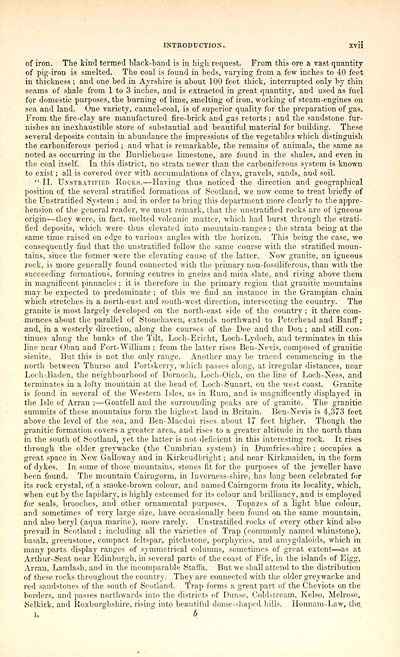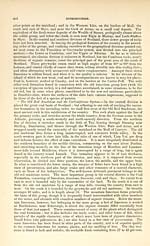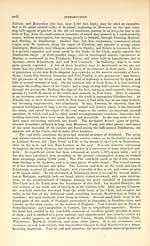Topographical, statistical, and historical gazetteer of Scotland > Volume 1
(29) Page xvii
Download files
Complete book:
Individual page:
Thumbnail gallery: Grid view | List view

INTRODUCTION- XVII
of iron. The kind termed black-band is in high request. From this ore a vast quantity
of pig-iron is smelted. The coal is found in beds, varying from a few inches to 40 feet
in thickness ; and one bed in Ayrshire is about 100 feet thick, interrupted only by thin
seams of shale from 1 to 3 inches, and is extracted in great quantity, and used as fuel
for domestic purposes,, the burning of lime, smelting of iron, working of steam-engines on
sea and land. One variety, cannel-coal, is of superior quality for the preparation of gas.
From the fire-clay are manufactured fire-brick and gas retorts ; and the sandstone fur-
nishes an inexhaustible store of substantial and beautiful material for building. These
several deposits contain in abundance the impressions of the vegetables ■which distinguish
the carboniferous period ; and what is remarkable, the remains of animals,, the same as
noted as occurring in the Burdiehouse limestone, are found in the shales, and even in
the coal itself. La this district, no strata newer than the carboniferous system is known
to exist ; all is covered over with accumulations of clays, gravels, sands, and soil.
" II. Unstratified Rocks.— Having thus noticed the direction and geographical
position of the several stratified formations of Scotland, we now come to treat briefly of
the Unstratified System ; and in order to bring this department? more clearly to the appre-
hension of the general reader, we must remark, that the unstratified rocks are of igneous
origin — they were, in fact, melted volcanic matter, which had burst through the strati-
fied deposits, which were thus elevated into mountain-ranges ; the strata being at the
same time raised on edge to various angles with the horizon. This being the case, we
consequently find that the unstratified follow the same course with the stratified moun-
tains, since the former were the elevating cause of the latter.. Now granite, an igneous
rock, is more generally found connected with the primary non-fossiliferous, than with the
succeeding formations, forming centres in gneiss and mica slate, and rising above them
in magnificent pinnacles ; it is therefore in the primary region that granitic mountains
may be expected to predominate ; of this we find an instance in the Grampian chain
which stretches in a north-east and south-west direction, intersecting the country. The
granite is most largely developed on the north-east side of. the country ; it there com-
mences about the parallel of Stonehaven, extends northward to Peterhead and Banff ;
and,, in a westerly direction, along the courses of the Dee and the Bon ; and still con-
tinues along the banks of the Tilt, Loch-Bricht, Loch-Lydoch, and terminates in this
line near Oban and Fort- William ; from the latter rises Ben-Nevis, composed of granitic
sienite. But this is not the only range. Another may be traced commencing in the
north between Thurso and Portskerry, which passes along, at irregular distances, near
Loch-Baden, the neighbourhood of Dornoch, Loch-Oieh, on the line of Loch-Ness, and
terminates in a lofty mountain at the head of Loch-Sunart, on the west coast. Granite
is found in several of. the Western Isles, as in Rum,, and is magnificently displayed in
the Isle of Arran ;— Goatfell and the surrounding peaks are of granite. The granitic
summits of these mountains form the highest land in Britain. Ben-Nevis is 4,.373 feet
above the level of the sea, and Ben-Macdui rises about 17 feet higher. Though the
granitic formation covers a greater area, and rises to a greater altitude in the north than
in the south of. Scotland, yet the latter is not deficient in this interesting, rock. It rises
through the older greywacke (the Cumbrian system) in Duinfries-shire ; occupies a
great space in. New Galloway and in Kirkcudbright ; and near Kirkmaiden, in the form
of dykes.. In some of those mountains, stones fit for the purposes of the jeweller have
been found. The mountain Cairngorm, in Inverness-shire, has long been celebrated for
its rock crystal, of. a snioke-brown colour, and named Cairngorm from its locality, which,
when cut by the lapidary, is highly esteemed for its colour and brilliancy, and is employed
for seals, brooches,, and other ornamental purposes. Topazes of a light blue colour,
and sometimes of very large size, have occasionally been found on the same mountain,
and also beryl (aqua marine), more rarely. Unstratified rocks of every other kind also
prevail in Scotland ; including all the varieties of Trap (commonly named whinstone),
basalt, greenstone, compact feltspar, pitchstone, porphyries, and amygdaloids, which in
many parts- display ranges of symmetrical columns, sometimes- of great extent~as at
Arthur-Seat near Edinburgh, in several parts of the coast of Fife, in the islands of Bigg,
Arran, Lamlash, and in the incomparable Staffa. But we shall attend to the distribution
of these rocks throughout the country. They are connected with the older greywacke and
red sandstones of the south of Scotland. Trap forms a great part of the Cheviots on the
borders, and passes northwards into the districts of Dunse, Coldstream, Kelso, Melrose,
Selkirk, and Roxburghshire, rising into beautiful dome-shaped hills. Hounam-Law, the.
i, b
of iron. The kind termed black-band is in high request. From this ore a vast quantity
of pig-iron is smelted. The coal is found in beds, varying from a few inches to 40 feet
in thickness ; and one bed in Ayrshire is about 100 feet thick, interrupted only by thin
seams of shale from 1 to 3 inches, and is extracted in great quantity, and used as fuel
for domestic purposes,, the burning of lime, smelting of iron, working of steam-engines on
sea and land. One variety, cannel-coal, is of superior quality for the preparation of gas.
From the fire-clay are manufactured fire-brick and gas retorts ; and the sandstone fur-
nishes an inexhaustible store of substantial and beautiful material for building. These
several deposits contain in abundance the impressions of the vegetables ■which distinguish
the carboniferous period ; and what is remarkable, the remains of animals,, the same as
noted as occurring in the Burdiehouse limestone, are found in the shales, and even in
the coal itself. La this district, no strata newer than the carboniferous system is known
to exist ; all is covered over with accumulations of clays, gravels, sands, and soil.
" II. Unstratified Rocks.— Having thus noticed the direction and geographical
position of the several stratified formations of Scotland, we now come to treat briefly of
the Unstratified System ; and in order to bring this department? more clearly to the appre-
hension of the general reader, we must remark, that the unstratified rocks are of igneous
origin — they were, in fact, melted volcanic matter, which had burst through the strati-
fied deposits, which were thus elevated into mountain-ranges ; the strata being at the
same time raised on edge to various angles with the horizon. This being the case, we
consequently find that the unstratified follow the same course with the stratified moun-
tains, since the former were the elevating cause of the latter.. Now granite, an igneous
rock, is more generally found connected with the primary non-fossiliferous, than with the
succeeding formations, forming centres in gneiss and mica slate, and rising above them
in magnificent pinnacles ; it is therefore in the primary region that granitic mountains
may be expected to predominate ; of this we find an instance in the Grampian chain
which stretches in a north-east and south-west direction, intersecting the country. The
granite is most largely developed on the north-east side of. the country ; it there com-
mences about the parallel of Stonehaven, extends northward to Peterhead and Banff ;
and,, in a westerly direction, along the courses of the Dee and the Bon ; and still con-
tinues along the banks of the Tilt, Loch-Bricht, Loch-Lydoch, and terminates in this
line near Oban and Fort- William ; from the latter rises Ben-Nevis, composed of granitic
sienite. But this is not the only range. Another may be traced commencing in the
north between Thurso and Portskerry, which passes along, at irregular distances, near
Loch-Baden, the neighbourhood of Dornoch, Loch-Oieh, on the line of Loch-Ness, and
terminates in a lofty mountain at the head of Loch-Sunart, on the west coast. Granite
is found in several of. the Western Isles, as in Rum,, and is magnificently displayed in
the Isle of Arran ;— Goatfell and the surrounding peaks are of granite. The granitic
summits of these mountains form the highest land in Britain. Ben-Nevis is 4,.373 feet
above the level of the sea, and Ben-Macdui rises about 17 feet higher. Though the
granitic formation covers a greater area, and rises to a greater altitude in the north than
in the south of. Scotland, yet the latter is not deficient in this interesting, rock. It rises
through the older greywacke (the Cumbrian system) in Duinfries-shire ; occupies a
great space in. New Galloway and in Kirkcudbright ; and near Kirkmaiden, in the form
of dykes.. In some of those mountains, stones fit for the purposes of the jeweller have
been found. The mountain Cairngorm, in Inverness-shire, has long been celebrated for
its rock crystal, of. a snioke-brown colour, and named Cairngorm from its locality, which,
when cut by the lapidary, is highly esteemed for its colour and brilliancy, and is employed
for seals, brooches,, and other ornamental purposes. Topazes of a light blue colour,
and sometimes of very large size, have occasionally been found on the same mountain,
and also beryl (aqua marine), more rarely. Unstratified rocks of every other kind also
prevail in Scotland ; including all the varieties of Trap (commonly named whinstone),
basalt, greenstone, compact feltspar, pitchstone, porphyries, and amygdaloids, which in
many parts- display ranges of symmetrical columns, sometimes- of great extent~as at
Arthur-Seat near Edinburgh, in several parts of the coast of Fife, in the islands of Bigg,
Arran, Lamlash, and in the incomparable Staffa. But we shall attend to the distribution
of these rocks throughout the country. They are connected with the older greywacke and
red sandstones of the south of Scotland. Trap forms a great part of the Cheviots on the
borders, and passes northwards into the districts of Dunse, Coldstream, Kelso, Melrose,
Selkirk, and Roxburghshire, rising into beautiful dome-shaped hills. Hounam-Law, the.
i, b
Set display mode to: Large image | Transcription
Images and transcriptions on this page, including medium image downloads, may be used under the Creative Commons Attribution 4.0 International Licence unless otherwise stated. ![]()
| Gazetteers of Scotland, 1803-1901 > Topographical, statistical, and historical gazetteer of Scotland > Volume 1 > (29) Page xvii |
|---|
| Permanent URL | https://digital.nls.uk/97437894 |
|---|
| Description | Volume first. A-H. |
|---|---|
| Attribution and copyright: |
|

